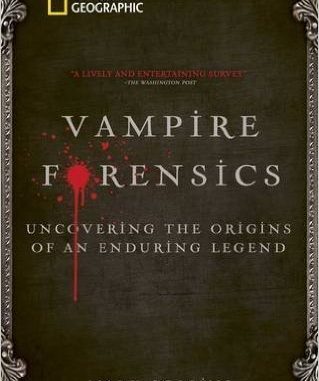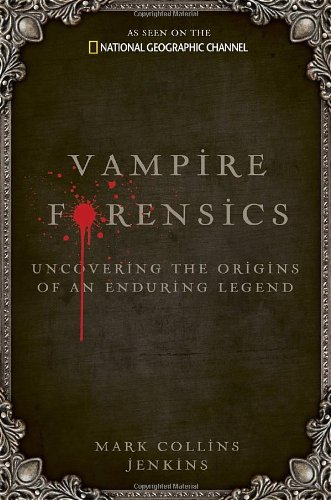
Vampire Forensics: Uncovering the Origins of an Enduring Legend
Author: Mark Collins Jenkins
Publisher: National Geographic
Pages: 304
ISBN: 1426207301
Price: 14.95 (paperback)
Vampire Forensics presents the lore and myth of vampires with an eye for science, particularly anthropology, psychology, physiology and, more to my liking, archaeology.
I have always enjoyed stories and movies about vampires. At age four, I was hooked on Dark Shadows, a bad soap opera that featured gothic ghouls like vampires, werewolves, and ghosts. But it was Barnabas Collins who made blood sucking cool. I think I was a vampire for Halloween more than once and always considered the vampire to be the king of Hollywood monsters. The Mummy, the Wolfman, all the ghosts, witches, and zombies -they all bowed to the vampire. Even the word itself looks sinister: vampire.
Now, in my studies of anthropology and archaeology, I was simply beside myself to discover Vampire Forensics. Mark Collins Jenkins presents a side of vampirism that I hadn’t previously considered and I suspect I’m not alone. Mixing pop culture, ancient mythology, and the evidence of physical remains and modern forensics, the author paints a picture that is both engaging and interesting; both entertaining and informing. Jenkins begins by highlighting vampires in pop culture, such as the novels of Anne Rice and Whitley Streiber as well as Richard Matheson’s I Am Legend. He then moves quickly into pathological explanations for vampirism that might explain the origins of superstitions and myths that erupted as “vampire epidemics” that coincided with 18th century outbreaks of disease or petulance, such as rabies and the plague.
What follows is a style of writing that compels the reader to turn page after page as he moves fluidly from historical records of sociopathic criminals and their gruesome behaviors, forensic and physiological evidence, and and the myth and lore associated with vampires in early historical accounts.
Consider this paragraph (pp. 32-33):
This litany of latter-day vampirism seems inexhaustible indeed. But it may have reached its grisly apogee in 1980, when 23-year-old James Riva, using gold-plated bullets, shot and killed his 74-year-old disabled grandmother. Riva then drank her blood as it spurted from the wounds. He had attacked her, Riva later claimed, because the voice of a vampire had instructed him to do so. Riva further declared that he himself was a 700-year-old vampire who required his grandmother’s blood to survive, only to discover that she was too old and dried up to serve that purpose. In 2009, he came up for parole. It was denied.
Compare with this one (pp. 127-128):
The tuberculosis bacillum, with justifiable exaggeration, might be said to consume the life force of its victim, overwhelming the victim’s will to live. Yet the pathogen has also evolved to spread via contagion, feeding off a new host before its old one dies, and so on down the line. Take away the understanding of microscopic pathogens, however, and what is left? A mysterious life force consuming one person after another, and believed powerful enough to act from afar -even from the grave.
And contrast with this one (p. 124):
Back on the knoll near Griswold, when the archaeologists had opened the coffin labeled “JB-55,” Bellantoni was momentarily taken aback. The skeleton looked like no other he had seen: These bones had been rearranged in a classic skull-and-crossbones pattern. This grave had been desecrated, apparently many decades earlier.
And you get an inkling of what you might expect from Vampire Forensics. One of the central stories in the book is that of ID6, a skeleton excavated from a from a 16th century mass grave that resulted from the plague outbreak in Venice, Italy that began in 1510. Half the population of the city was infected with the plague by 1576, most of them dying from it. Graves were opened and reopened in order to dispose of the bodies. 400 years after the fact, archaeologist Matteo Borrini excavated the remains, and happened upon the partial skeleton of an elderly woman who had a brick shoved, post-mortem, in her mouth. The mystery led Dr. Borrini to the legend of the “chewing dead,” which was held by superstition to mean that a corpse would exhibit vampire-like behavior of eating neighboring corpses.
That ID6 was thought to be a “chewing corpse” or Nachzehrer (“after-devourer”), was likely fueled by the superstitions held by people of the day, understandably frightened by the horror of the plague. Perhaps the blood on a death shroud near the mouth, flowing during the decay process and the bloating from gases, giving the appearance of having just gorged on a meal of fellow corpses was enough to cause some poor grave digger to take no chances and, thus, ram a brick in its mouth before reburying in hopes that the vampire might starve to death.
As an archaeologist and anthropologist who’s primary interest is in the ancient beliefs and superstitions of people in prehistory and early history, I found Vampire Forensics to be informative and inspiring. For me, the approach was fresh and I learned a few things. As a fan of vampire lore in both mythology and pop culture, I found the author’s work to be as entertaining as any modern thriller and it was difficult to put the book down and do other things… like sleep or work.
If you’re interested in Vampire Forensics, follow this link to the book at Amazon or check the link in my sidebar, just click on the book cover.

OMG I love you! Where have you been all my life
I’ve been right here! Waiting for you to drop in! 🙂
Nice Youtube site you have there… I’ll have to watch the vids when I’m not surfing on the sly at work…
great review. thanks.
Wow ! Yay ! It’s a real book ! I want it !
Thanks for writing it up !
Not only is it a real book, but I truly enjoyed it. It was a lot of fun reading! Lots of science and mythology mixed in with some really grotesque descriptions reminiscent of Gothic horror novels.